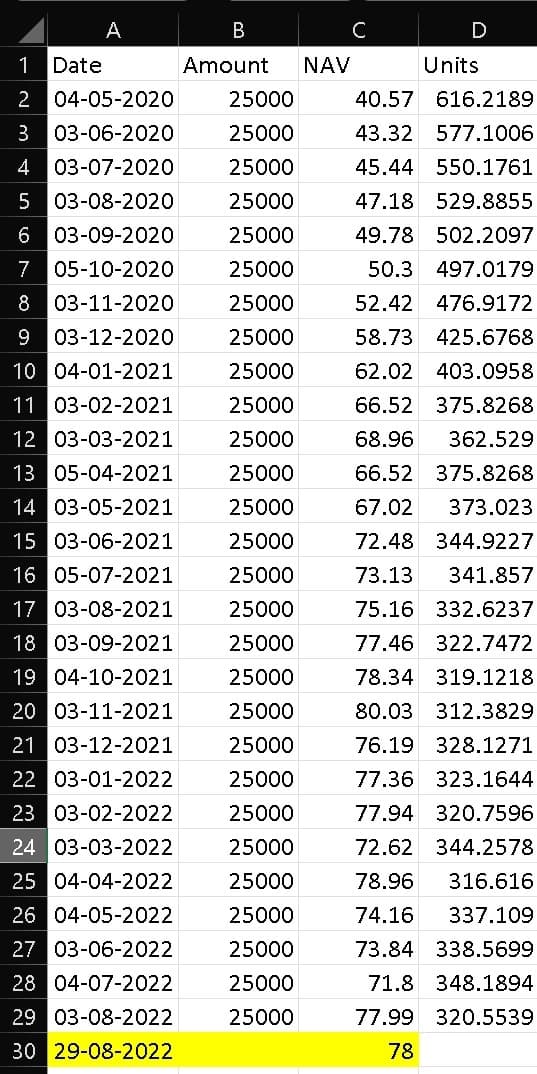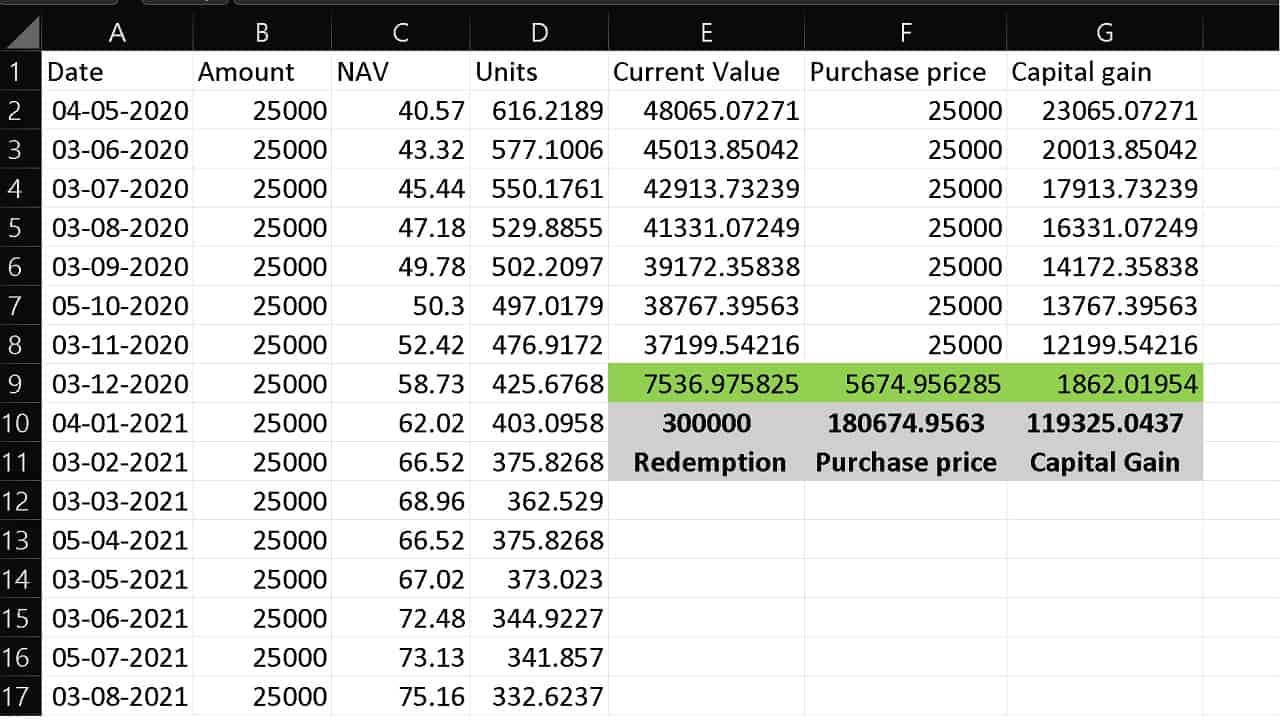A reader asks, “I have a question regarding Taxation on withdrawal of SIP mutual fund units. Can you throw some light on how the units would be taxed?”
First, it must be understood that the SIP is just an automated way of buying mutual funds units each month (typically). However you buy mutual fund units – via SIP or lump sum at arbitrary intervals, the taxation rule is the same.
The only difference concerns the type of fund: equity or non-equity (debt funds, gold funds, international funds and all fund of funds).
Now let us consider a schedule of mutual fund transactions. All of these except the last entry represent purchases. We have used our Google sheets MF and stock tracker to generate this instantly.

The last line in yellow represents the redemption date with a NAV of Rs. 78 per unit. Now, suppose we redeem Rs. 3 lakhs. We need to find out how many units will be redeemed. We also need to find the age of such units. In this example, we will assume all units are older than one year. So we shall only consider long-term capital gains tax of equity funds.
Join 32,000+ readers and get free money management solutions delivered to your inbox! Subscribe to get posts via email! (Link takes you to our email sign-up form)
🔥Want to create a complete financial plan? Learn goal-based investing? Exclusive access to our DIY tools? Increase your income with your skills? Enjoy massive discounts on our robo-advisory tool & courses! 🔥
This is easy: 300000/78 = 3846.1538 units (technically, NAV is declared up to 4 digits, so the units also should be rounded off to four digits, but most NAV portals only report up to 2 digits).
The next step is to determine which units will be redeemed. The rule is first-in, first-out. That is, units invested first will be redeemed first. This is easier said than done in a SIP or in any situation with multiple transactions.
In the image, column E (cell E2) represents the units’ current value in column D’s corresponding rows (cell D2). For example, 616.2189 units purchased on 4-5-2020 have a current value (date of redemption) of 616.2189 x 78 = Rs. 48,065.07271. This is well below the total redemption amount of Rs. 3 lakhs.
So we keep going. E3, E4, E5, etc., while also noting their sum.

The sum of cells E2 to E8 is Rs. 292463.0242. So all the units corresponding to the first seven purchases (cells D2 to D8) will be redeemed.
Since the total redemption amount is Rs. 3 lakhs, only units currently worth 300000 – 292463.0242 = Rs. 7536.9758 will be redeemed. This is shown in cell E9 (highlighted in green).
Using the current NAV of Rs. 78, we find that this corresponds to 96.6279 units purchased on 3-12-2020 (row 9). The NAV on this date is Rs. 58.73 per unit.
The purchase price of these units = 96.6279 x 58.73 = Rs. 5674.9563.
Now we pay tax on the capital gain. Capital gain = current price minus purchase price.
We shall assume the fund is an equity fund. In the case of a non-equity fund, the purchase price will have to be modified using the cost inflation index. This is illustrated here: Taxation of international mutual funds explained with an example.
Some units were purchased at a NAV of Rs. 40.57 per unit and some at a NAV of Rs. 43.32 per unit etc. Therefore the capital gain will have to be accounted for with the correct purchase price. Column G in the image above = Column E minus Column F (corresponding rows).
- The sum of the current value of the units redeemed: Rs. 3,00,000
- The sum of the purchase price of the units redeemed: Rs. 180674.9563
- The total capital gain is the difference: Rs. 119325.0437
Since this is an equity fund, the first Rs. 1 lakh is tax-free. So the effective taxable gain is only Rs. 19325.0437.
Now 10% of this will be taxed. So Rs. 1932.5043. There is a 4% education cess on this = Rs. 77.3. So the total tax is Rs. 2009.8045. So the post-tax redemption is Rs. 300000 minus Rs. 2009.8045 = Rs. 297990.1955.
Imagine how complex the calculation will be if (a) some units are less than 365 days old and some older or (b) if it is a non-equity fund. Then we need to determine the cost inflation index in each financial year of the redeemed units and inflate the purchase price to the financial year of purchase (see example linked above) or (c) if there are multiple redemptions in the past – we need to ensure redeemed units are not accounted for again.
This naturally brings a question: “If I wish to redeem Rs. 1 lakh from equity funds each year, can I find the approximate units to redeem?” As a spreadsheet implementation challenge, developing a tool for this would be interesting. However, we do not recommend this as it is unnecessary. See examples here: Should I book yearly profits (up to the tax-free limit of one lakh) to lower Equity LTCG Tax?
🔥Enjoy massive discounts on our courses, robo-advisory tool and exclusive investor circle! 🔥& join our community of 7000+ users!
Use our Robo-advisory Tool for a start-to-finish financial plan! ⇐ More than 2,500 investors and advisors use this!
Track your mutual funds and stock investments with this Google Sheet!
We also publish monthly equity mutual funds, debt and hybrid mutual funds, index funds and ETF screeners and momentum, low-volatility stock screeners.





- Do you have a comment about the above article? Reach out to us on Twitter: @freefincal or @pattufreefincal
- Have a question? Subscribe to our newsletter using the form below.
- Hit 'reply' to any email from us! We do not offer personalized investment advice. We can write a detailed article without mentioning your name if you have a generic question.
Join 32,000+ readers and get free money management solutions delivered to your inbox! Subscribe to get posts via email! (Link takes you to our email sign-up form)
About The Author
 Dr M. Pattabiraman(PhD) is the founder, managing editor and primary author of freefincal. He is an associate professor at the Indian Institute of Technology, Madras. He has over ten years of experience publishing news analysis, research and financial product development. Connect with him via Twitter(X), Linkedin, or YouTube. Pattabiraman has co-authored three print books: (1) You can be rich too with goal-based investing (CNBC TV18) for DIY investors. (2) Gamechanger for young earners. (3) Chinchu Gets a Superpower! for kids. He has also written seven other free e-books on various money management topics. He is a patron and co-founder of “Fee-only India,” an organisation promoting unbiased, commission-free investment advice.
Dr M. Pattabiraman(PhD) is the founder, managing editor and primary author of freefincal. He is an associate professor at the Indian Institute of Technology, Madras. He has over ten years of experience publishing news analysis, research and financial product development. Connect with him via Twitter(X), Linkedin, or YouTube. Pattabiraman has co-authored three print books: (1) You can be rich too with goal-based investing (CNBC TV18) for DIY investors. (2) Gamechanger for young earners. (3) Chinchu Gets a Superpower! for kids. He has also written seven other free e-books on various money management topics. He is a patron and co-founder of “Fee-only India,” an organisation promoting unbiased, commission-free investment advice.Our flagship course! Learn to manage your portfolio like a pro to achieve your goals regardless of market conditions! ⇐ More than 3,000 investors and advisors are part of our exclusive community! Get clarity on how to plan for your goals and achieve the necessary corpus no matter the market condition is!! Watch the first lecture for free! One-time payment! No recurring fees! Life-long access to videos! Reduce fear, uncertainty and doubt while investing! Learn how to plan for your goals before and after retirement with confidence.
Our new course! Increase your income by getting people to pay for your skills! ⇐ More than 700 salaried employees, entrepreneurs and financial advisors are part of our exclusive community! Learn how to get people to pay for your skills! Whether you are a professional or small business owner who wants more clients via online visibility or a salaried person wanting a side income or passive income, we will show you how to achieve this by showcasing your skills and building a community that trusts and pays you! (watch 1st lecture for free). One-time payment! No recurring fees! Life-long access to videos!
Our new book for kids: “Chinchu Gets a Superpower!” is now available!


Must-read book even for adults! This is something that every parent should teach their kids right from their young age. The importance of money management and decision making based on their wants and needs. Very nicely written in simple terms. - Arun.Buy the book: Chinchu gets a superpower for your child!
How to profit from content writing: Our new ebook is for those interested in getting side income via content writing. It is available at a 50% discount for Rs. 500 only!
Do you want to check if the market is overvalued or undervalued? Use our market valuation tool (it will work with any index!), or get the Tactical Buy/Sell timing tool!
We publish monthly mutual fund screeners and momentum, low-volatility stock screeners.
About freefincal & its content policy. Freefincal is a News Media Organization dedicated to providing original analysis, reports, reviews and insights on mutual funds, stocks, investing, retirement and personal finance developments. We do so without conflict of interest and bias. Follow us on Google News. Freefincal serves more than three million readers a year (5 million page views) with articles based only on factual information and detailed analysis by its authors. All statements made will be verified with credible and knowledgeable sources before publication. Freefincal does not publish paid articles, promotions, PR, satire or opinions without data. All opinions will be inferences backed by verifiable, reproducible evidence/data. Contact information: To get in touch, use this contact form. (Sponsored posts or paid collaborations will not be entertained.)
Connect with us on social media
- Twitter @freefincal
- Subscribe to our YouTube Videos
- Posts feed via Feedburner.
Our publications
You Can Be Rich Too with Goal-Based Investing
 Published by CNBC TV18, this book is meant to help you ask the right questions and seek the correct answers, and since it comes with nine online calculators, you can also create custom solutions for your lifestyle! Get it now.
Published by CNBC TV18, this book is meant to help you ask the right questions and seek the correct answers, and since it comes with nine online calculators, you can also create custom solutions for your lifestyle! Get it now.Gamechanger: Forget Startups, Join Corporate & Still Live the Rich Life You Want
 This book is meant for young earners to get their basics right from day one! It will also help you travel to exotic places at a low cost! Get it or gift it to a young earner.
This book is meant for young earners to get their basics right from day one! It will also help you travel to exotic places at a low cost! Get it or gift it to a young earner.Your Ultimate Guide to Travel
 This is an in-depth dive into vacation planning, finding cheap flights, budget accommodation, what to do when travelling, and how travelling slowly is better financially and psychologically, with links to the web pages and hand-holding at every step. Get the pdf for Rs 300 (instant download)
This is an in-depth dive into vacation planning, finding cheap flights, budget accommodation, what to do when travelling, and how travelling slowly is better financially and psychologically, with links to the web pages and hand-holding at every step. Get the pdf for Rs 300 (instant download)